Seven aspects of alignment in digital supply chains: When your client is your supplier
What we do in this digital delivery gig is complex. It is not enough for the client or supplier to be “right”. Seven areas in particular increase the challenges of getting projects over the line. If we get our context right and address the details, it can make for improved phone conversations.

When your client is your supplier – a hypothetical case study
I pick up the phone and dial my supplier. Things are not good. Once again, my supplier has failed to provide deliverables critical to getting my client’s release into production. Their content is late, the data they provided is incorrect and requires rework, they released code at midnight last night that made yesterday’s development irrelevant, and the pre-production environment they set up for my client’s approval has fallen over again.
My supplier’s voice on the other end is both apologetic and defensive. My supplier and I discuss the complexity of the technology, tight delivery timeframes, and staff shortages. I stress the importance of the delivery and the investment in client dollars riding on this release. My supplier makes a few promises as I set the phone down to prepare for the uncomfortable call to my client to communicate the resulting delays.
I pick up the phone and hit redial to call my client – same person, different context. I break the news that we will not meet the deadline. The response is not pleasant. The client does not want to hear about late deliveries from my supplier, as I am accountable for my supply chain. The only acceptable response is an expectation of delivery and how much we will invest to get the delivery over the line.
I set the phone down again and ponder the dichotomy of my situation as I plan the weekend’s work.
Seven aspects of alignment in the digital supply chain
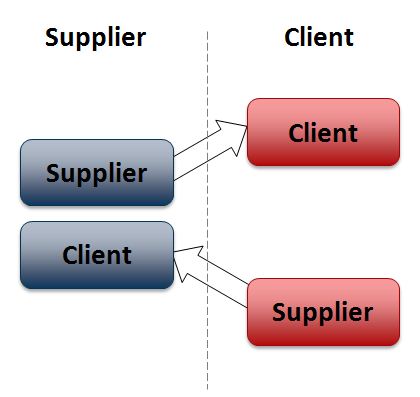
The exaggerated, seemingly schizophrenic situation above demonstrates the complexity of an integrated digital supply chain.
When we think supply chain, discussions typically focus on linear retail or manufacturing situations. Companies such as Apple, Toyota, Coke, Dell, and Wall-mart attribute their success to getting external product into their doors and distributed back out to consumers.
Khaista & Zualkernan highlight the success of IT systems in particular as being based on alignment in key areas of communication, competency, governance, partnership, scope, architecture, and skills. Success is also dependent upon a common approach towards seven areas:
1. Assets
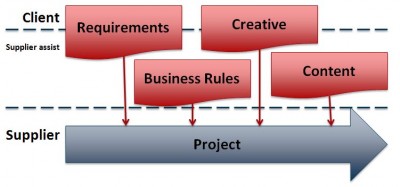
Digital suppliers rely on client deliverables such as project requirements, business rules, content, approvals, and creative assets. These come from a range of client business units such as marketing, HR, operations, or finance.
2. Data

Data is distinct from other assets as it forms the assumptions upon which transactional digital solutions are based. The interface and business logic is based upon expected product pricing, vouchers, coupons, discounts, event schedules, plans, and rates. These are all subject to change at the last minute before launch in highly competitive markets.
3. Environments

Prior to reaching the public, software passes through development, staging, user acceptance testing (UAT), and pre-production environments before hitting the real-world production environment. Development and staging environments are typically maintained by the supplier, UAT and beyond by the client. These environments need to be consistent to ensure testing is performed in as close to production scenarios as possible and that issues raised are not due to the environment-only.
4. Mixed teams
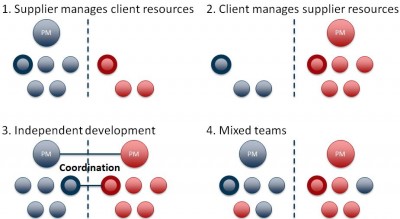
Project management on each side are responsible for resources on the other. Each team delivers to the other, with added risk of politics and protectionism inherent to in-group status.
5. Shared procedures and policies
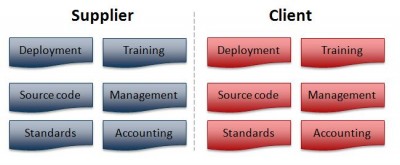
Integrated supply chains require common procedures and policies around areas such as source code management, coding standards, package deployments, training, project management methodologies, and accounting practices. Situations devolve into chaos without a common language and way of doing things.
6. Shifting technology
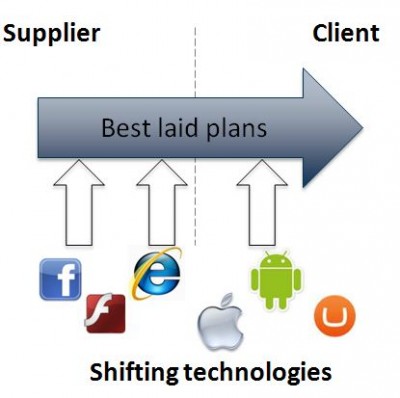
The only safe assumption in digital projects is that there will be change. A 12-month iPhone project can require the complete rebuild of core software engines to accommodate new iOS operating systems. Solutions and strategies built on the Facebook platform can be impacted by changes by Facebook. Core software platforms may suddenly disappear weeks before launch, such as the recent demise of content management system Umbraco 5.
7. Culture and values
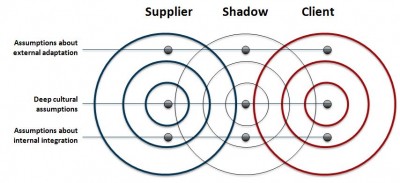
The points above require tight integration between organisations, creating what can be referred to as a shadow culture at the intersection points. Culture is the leading cause of failure in merger or acquisitions, and similar could be said for enterprise supply chain relationships. Unless there is sufficient alignment or intentional mitigation where alignment is lacking, the relationship is at risk.
Alignment versus conformance: A matter of context
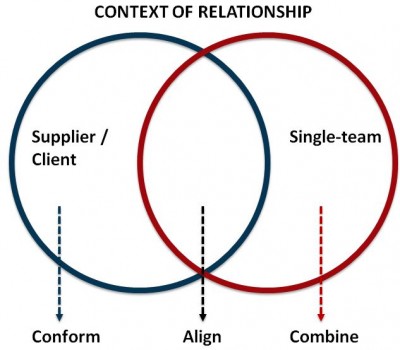
How these are managed depends upon the context of your relationship. The realities of the supplier-client context are necessary to maintain accountability:
- Negotiated exchanges of benefits are performed in each party’s perceived best interest.
- Policy is reinforced through escalating reward and coercion mechanisms.
- Each party is incentivised to have as many options as possible to reduce dependence upon the other party, while at the same time trying to increase dependence of the other party on their role in the relationship.
The downside of a strict client-supplier context is that it can promote blame and protectionism. Research shows it may not be ideal for custom digital delivery situations:
- Situations involving complex knowledge transfers and shared decision-making are more suitable to single-supplier relationships.
- Relationships focused on ownership and power result in misalignment and game playing, with rules defined to suit the individual’s best interest to the detriment of the relationship.
- In situations of increased uncertainty, supply chains responsiveness inherent to a close relationship is more likely to bring success.
Both contexts of “client-supplier and “single-team” are required to bring the dual benefits of accountability and efficiency. Combining these approaches allows the supplier to assist the client with their deliverables as a paid commercial exercise to the benefit of both parties. Does the supplier have resources that can assist with assets? Can the supplier support scripting the data? If mixed teams are a challenge, can the supplier invest in additional project management to get the project over the line?
Alignment is critical for supply chain success. Define and agree on context to allow a blame-free focus on the seven areas. Bring the individual areas in alignment to then give the redial button new meaning.
